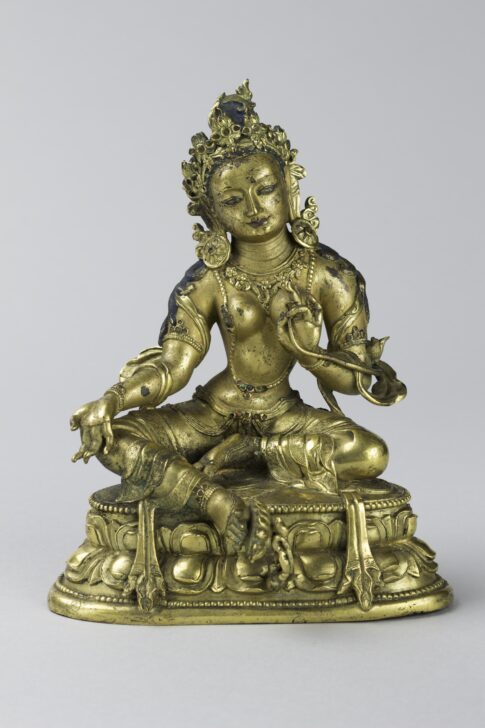Bodhisattva Tara (Tibetan, Jetsun Dolma)
Tibetan; Nepali

Description
Subject Matter:
Tara is a relatively late addition to the Buddhist pantheon, being part of a larger Buddhist response in northeastern India to thriving Hindu cults, especially the emerging popularity of goddesses. A female bodhisattva, she is considered the consort or female aspect of Avalokitesara, the bodhisattva of compassion.
Tara is widely revered by followers of Tibetan Buddhism in the Himalayas and Mongolia; to laymen, she is a deity who can be approached without the intercession of a monk, and who will offer respite from suffering, while to the tantric adept, she is the focus for advanced yogic practices. She is depicted as a youthful, sensual woman.
Physical Description:
A suberply cast hollow bronze figure of Tara, a Buddhist goddess, shown leated in the lalitasana pose ("royal ease," with one knee bent and the other relaxed), her right hand extended to her right knee in vara mudra (the gesture of charity), and her left hand in vitarka mudra (the gesture of teaching, with the thumb and third finger brought together). She wears a dhoti and jewelry, including an elaborate tiara and enormous lotus-petal design ear plugs. Her face has a broad, open forehead, with wide, slightly arching brows; her eyes are downcast with "s"-shaped upper lids; her nose is straight and long, and her mouth, in a curved Cupid's bow shape, is small but full. Her torso leans slightly to her left, which is balanced by the right tilt of her head. She sits on a double lotus dais with beaded upper and lower rims. The image and the base were case in one piece in the lost-wax method. There are traces of red paint for her mouth and blue paint for her hair.
Usage Rights:
If you are interested in using an image for a publication, please visit https://umma.umich.edu/request-image/ for more information and to fill out the online Image Rights and Reproductions Request Form.